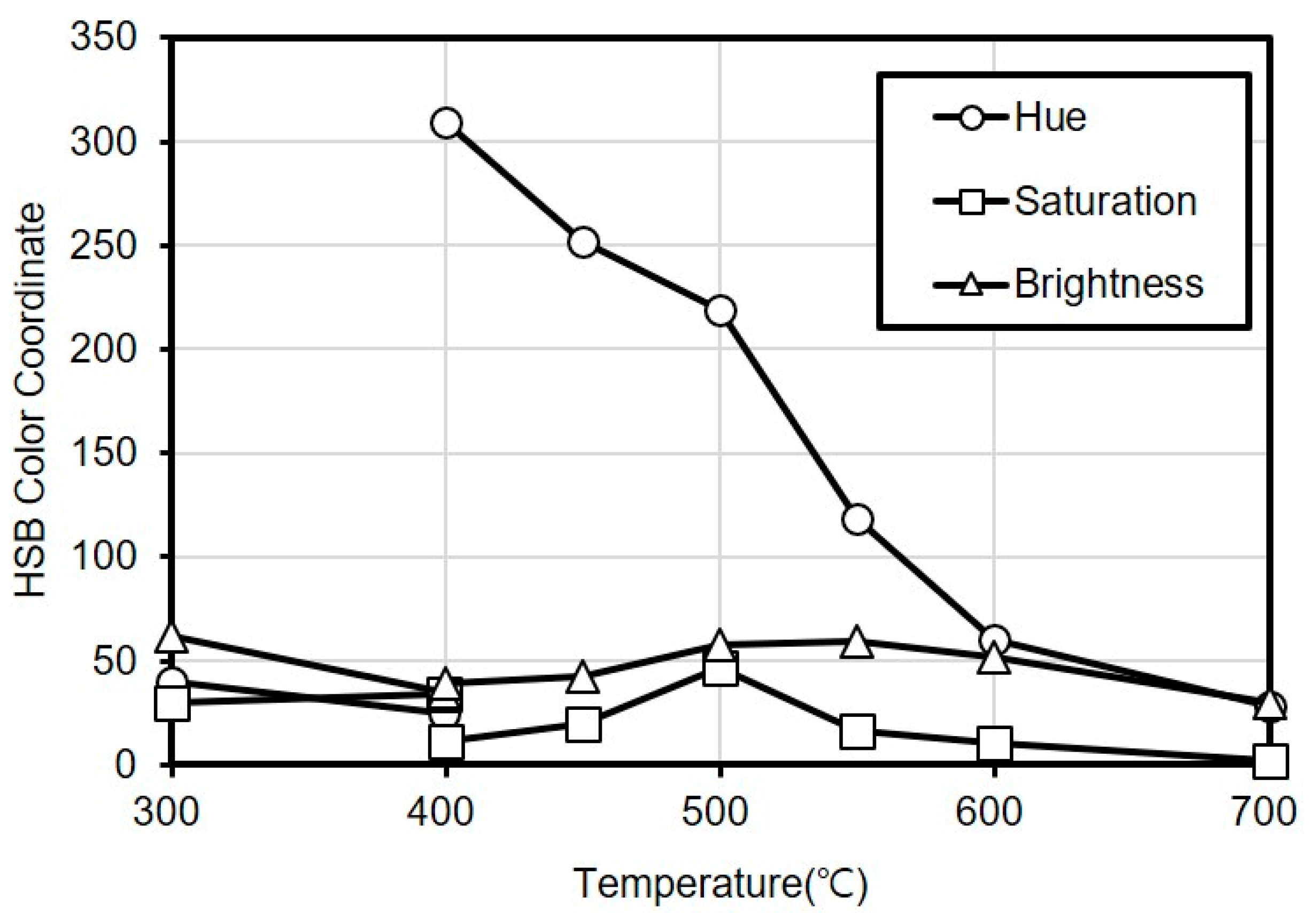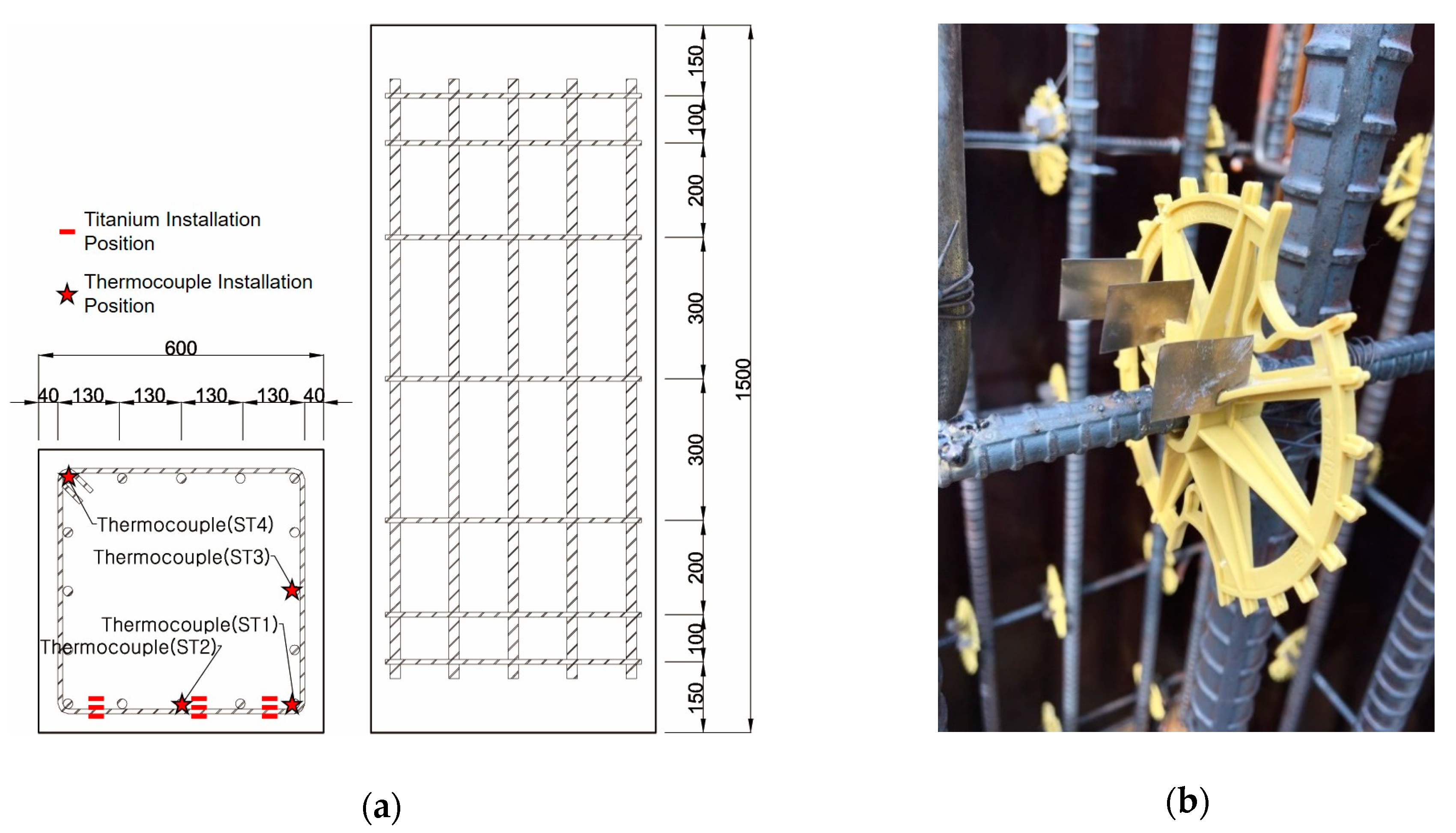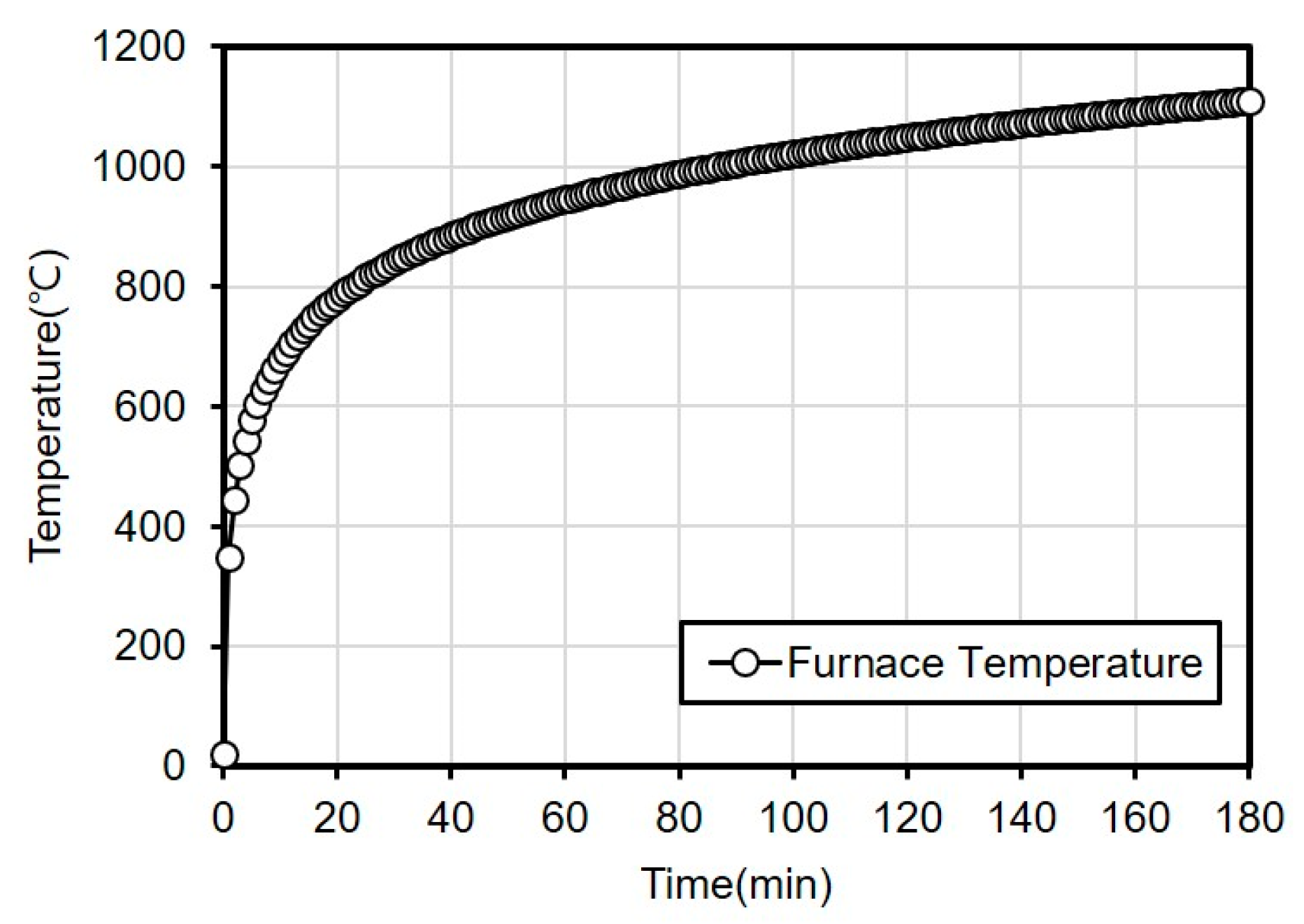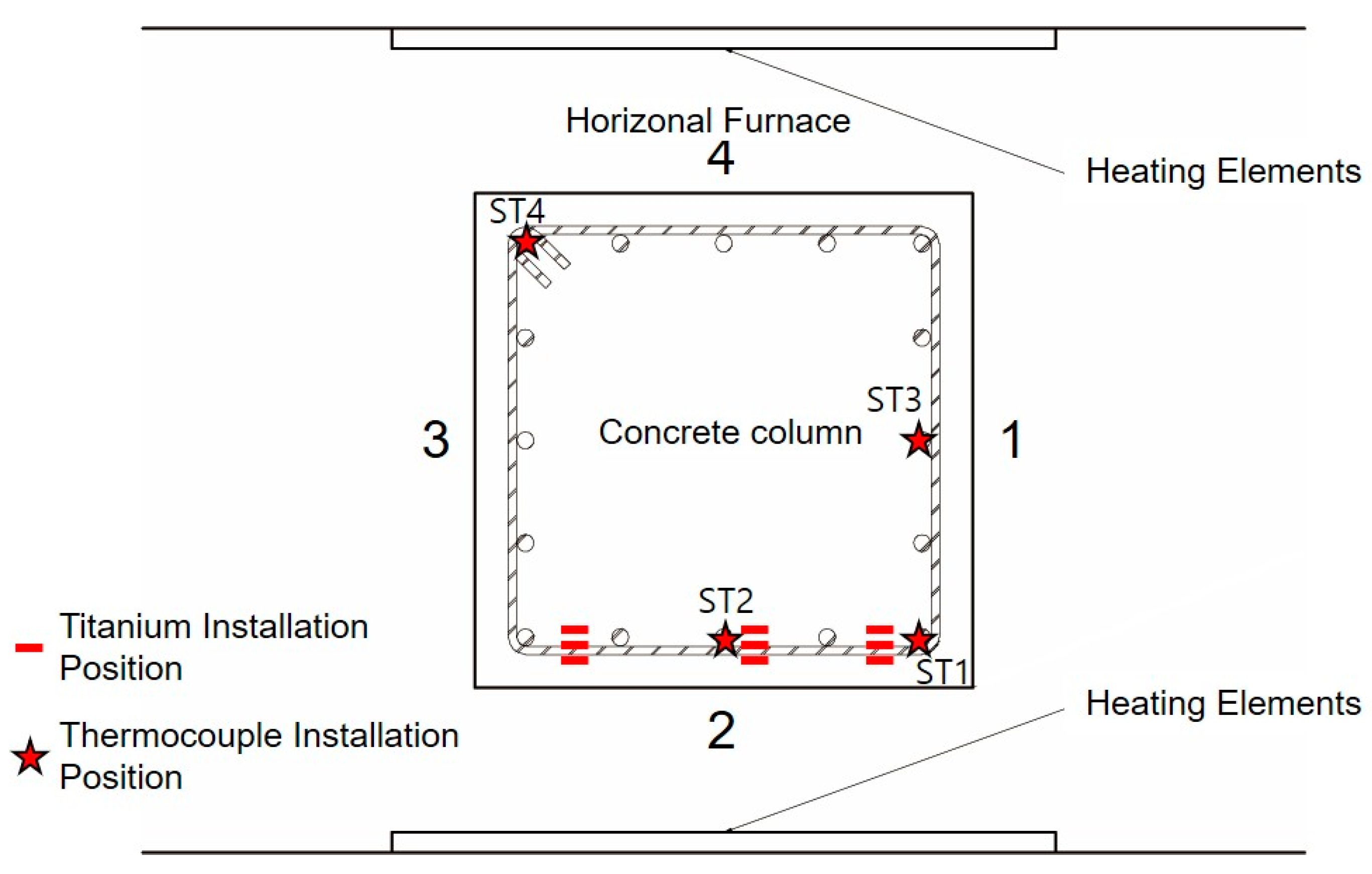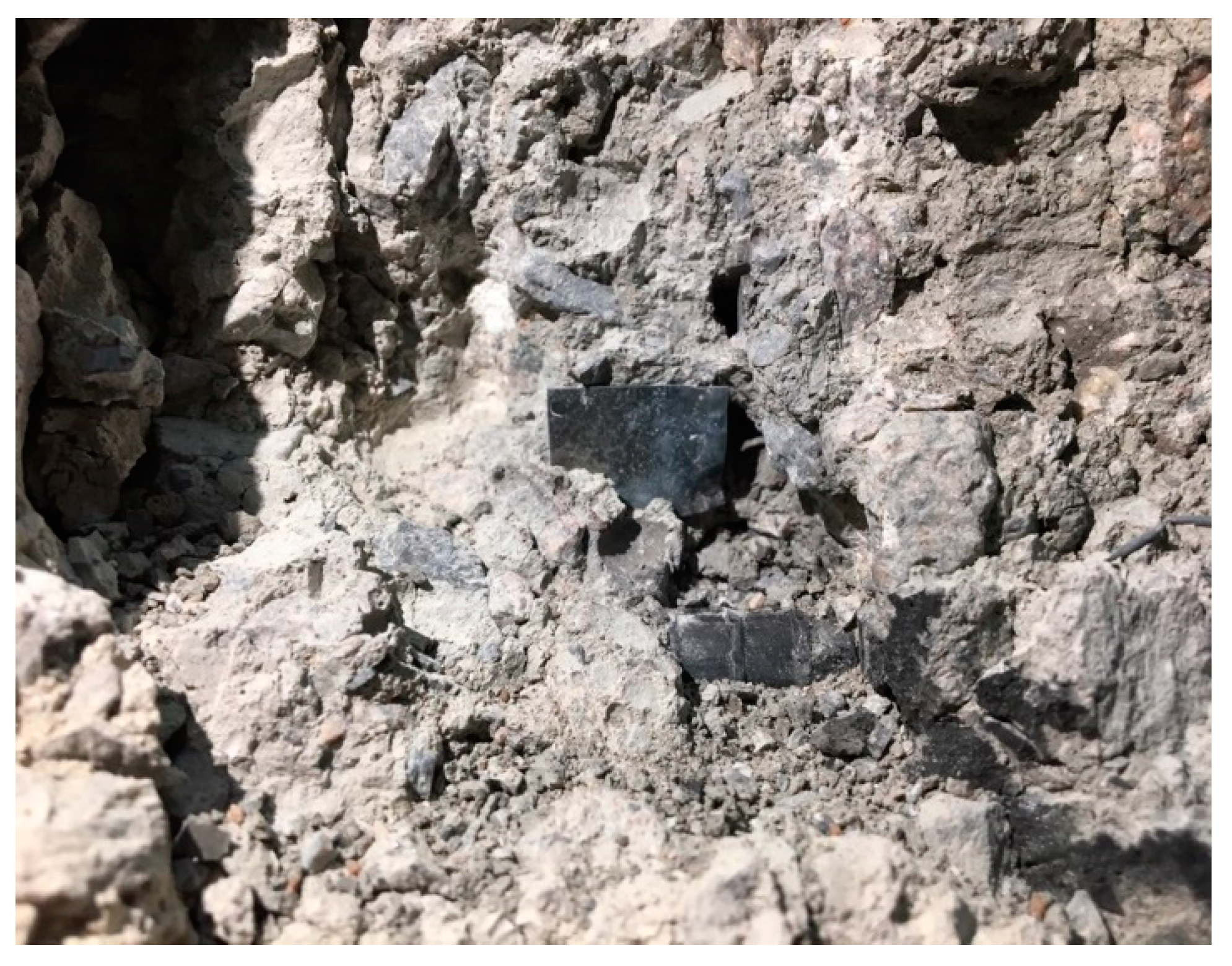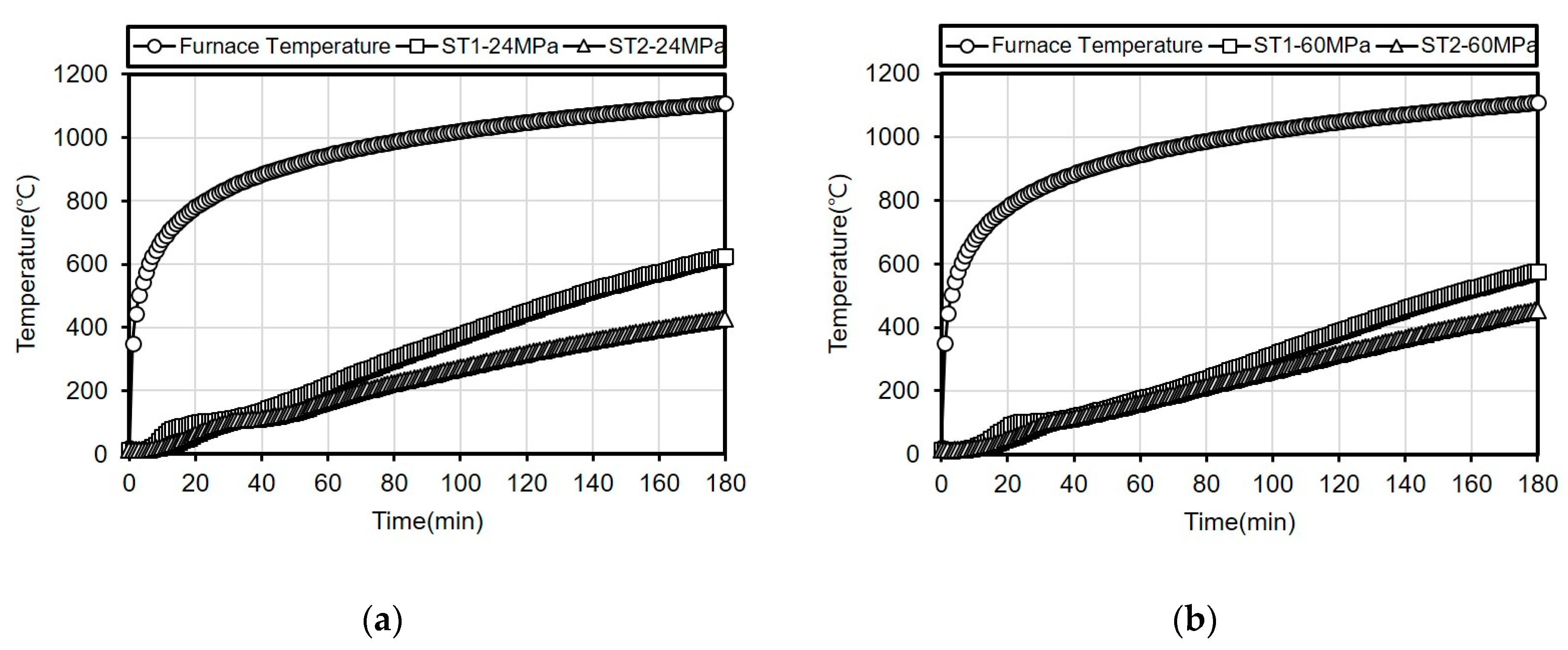1. Introduction and Background
Concrete, which is the most widely used structural material for buildings, has been generally recognized as typically fire-resistant due to its significantly lower thermal conductivity and thermal diffusion coefficient as compared to those of other structural materials. The degradation of concrete by exposure to high temperatures is, however, known to be severe because of the rapid decrease in its strength when subjected to temperatures higher than 600 °C [
1,
2]. In particular, when a concrete structure is exposed to fire, direct damage such as exposing of the main reinforcements can occur due to spalling of the members and scaling of concrete, besides its structural safety can get significantly compromised due to some additional damage such as the deformation of beams, buckling of columns, and initiation of shear cracks by thermal expansion [
3]. In addition, the cement paste causes a serious impact on the durability of concrete by undergoing chemical changes such as the dehydration of Ca(OH)
2 at approximately 500 °C and the decomposition of the C–S–H gel at approximately 700 °C. Even after the exposure to fire, the dehydrated CaO reacts with the moisture in the air and is rehydrated to Ca(OH)
2, whose expanded volume then generates microcracks [
4,
5,
6,
7]. Owing to these reasons, when fire damage occurs to an RC structure, timely repair and reinforcement are required. There is, however, no established evaluation criterion that clearly defines the performance degradation extent of concrete structures after a fire. Therefore, a quick and accurate diagnosis and evaluation techniques are required, for which it is important to quantitatively evaluate the heating temperature.
Several studies on the estimation of the heating temperature of fire-damaged concrete have been reported previously. The simplest method is to visually observe the discoloration and properties of the affected surface. When concrete is exposed to high temperatures, it acquires a pink or purple color at 300–600 °C, pale gray at 600–900 °C, and pale yellow at 900–1000 °C due to the oxidation of the iron compounds [
8,
9,
10]. While the above observations can estimate the heating temperature of concrete by quantifying the discoloration characteristics of the concrete surface at high temperatures, this method is limited to the cases, which are composed of 100% ordinary Portland cement (OPC). In recent times when the use of concrete admixtures and composite cements has increased, this method is very impractical because the discoloration characteristics must be calibrated individually for each mix. In addition, the discoloration of the concrete surfaces cannot be observed during a fire due to the black smoke and soot.
As such, in the fire engineering design of Eurocode 2 [
11], the 500 °C isotherm method is applied as a simplified assessment method that ignores the strength and elasticity of the part exceeding the 500 °C mark. The Architectural Institute of Japan [
12] also presented a method for easily estimating whether the heating temperature of concrete exceeded 500 °C using the neutralization depth measurement method by a phenolphthalein solution. According to a previous study, however, a fire duration of more than three hours is required at 500 °C to completely pyrolyze the Ca(OH)
2, thus causing the heating temperature to be underestimated when the exposure is less than three hours as the phenolphthalein solution reacts to the remaining traces of Ca(OH)
2 and exhibits discoloration [
13].
Other heating temperature estimation methods include the ultraviolet (UV) spectrum method and the ultrasonic pulse velocity measurement method. Yoshida. M et al. reported a method of estimating the maximum temperature of fire-damaged concrete by measuring changes in the compounds present in the concrete after a fire using UV spectrum [
14]. Bo-Tsun Chen et al. reported a method of estimating the heating temperature of concrete through the compressive strength and split tensile strength of concrete as well as using a support vector machine (SVM) on the ultrasonic pulse velocity data [
15]. Yang Han et al. reported a method of estimating the maximum temperature experienced by fire-damaged concrete by measuring the acoustic decrepitation of fluid inclusion in the natural silica sand used as the fine aggregate in concrete using the characteristic of fluid inclusion that it is not recoverable when damaged by a fire [
16]. The above estimation methods however by a thorough analysis reveal some limitations in being applied to the field because the considerable efforts and time that are required to estimate the heating temperature by depth after collecting core samples from all the fire exposed locations when the fire damaged region is wide. Moreover, when the heating temperature is estimated in a fire-damaged structure using changes in the concrete compounds as indicators, the estimation can be inaccurate because the concrete compounds getting rehydrated due to the water that had been sprinkled for fire suppression. Thus, it is difficult and unreliable to estimate the actual heating temperature using the above methods [
17].
Certain studies on the behavior of the steel reinforcements rather than that of the concrete at high temperatures to estimate the heating temperature of fire-damaged RC structures have been reported. Roberto Felicetti et al. compared and evaluated the residual performance of various steel reinforcement types through the M-N envelope [
18]. They could approximate the heating temperature at a specific depth of an RC structure where the steel reinforcement was located, but could not determine the heating temperature of the concrete by depth.
Therefore, quantitative estimation of the heating temperature by depth is required to enable timely repair and reinforcement of fire damaged concrete buildings. In particular, considering the pyrolysis temperature of potassium hydroxide, which is 450–550 °C, and the 500 °C isotherm method of Eurocode 2, this study aims to propose a novel method for quick and accurate estimation by setting 400–600 °C as the main goal of heating temperature estimation.
1.1. Discoloration Characteristics of Titanium
Titanium metal is silvery white in color under normal conditions. When subjected to high temperatures, it has been reported to exhibit different colors on its surface depending on the temperature. This is because the film thickness on the titanium surface changes and the light reflected from the metal surface causes interference. It has been reported that the color of the metal surface appears yellow at 300 °C, purple at 400 °C, blue at 500 °C, gray at 600–800 °C, and white at 900–1000 °C [
19,
20,
21]. This study aimed to utilize these discoloration characteristics to estimate the heating temperature of concrete by depth.
1.2. Color Analysis
There are various methods to express colors, but they can be broadly categorized into two methods; one, the method of expressing in the combinations of red, green, and blue (RGB), and the other in terms of hue, saturation, and brightness (HSB).
The RGB coordinates express the colors by mixing the three primary colors, i.e., red, green, and blue. They express each of these colors using numbers from zero to 255 depending on their respective brightness. This method is referred to as “additive color mixture” because the mixing of the three colors increases the brightness. It, however, has limitations in quantitatively expressing the relationship between the temperature and the discoloration characteristics because the proportions of the mixed colors can be different even for similar colors.
On the other hand, the HSB coordinates are expressed by the hue, saturation, and brightness, where the hue is quantified by angle, the saturation represents the mixing degree of the pure colors with white, and the brightness represents the intensity of light reflected from a material, i.e., relative brightness and darkness [
22]. Therefore, the higher the saturation, the closer is the displayed color to the original color; the lower the saturation, the closer the color is to white. Furthermore, the higher the brightness, the closer the color is to the original color; the lower the brightness, the darker it becomes [
8].
As such, in this study, the HSB color analysis method was adopted since it is capable of quantitatively expressing the relationship between the temperature and the discoloration characteristics of titanium.
3. Results and Discussion
3.1. Results of 24 MPa Specimen
Table 7 shows the estimated heating temperature of the titanium metal embedded in the 24 MPa—class short column specimen through its discoloration characteristics and the color analysis. At a 3-cm depth, the titanium metal turns gray or black at all the positions of rows A to E. At a 5-cm depth, the corners turn blue or green while the centers turn violet or blue. At a 7-cm depth, the center does not show any color change, but the corners turn violet or yellow.
When the color coordinate values of titanium metal were examined, almost all the titanium metal probes at a 3-cm depth showed saturation values less than 8 and brightness values less than 30. Based on these, the heating temperature was estimated using the regression equations. It was implied that the heating temperature reached 700 °C, which is the maximum detectable temperature via discoloration of titanium metal.
At a 5-cm depth, the hue angle values ranged from 35 to 270. Based on this, the heating temperature was estimated to be between 320 and 600 °C.
At a 7-cm depth, the hue angle values ranged from 5 to 260, and thus the heating temperature was estimated to be between 200 and 500 °C.
When the heating temperature of the specimen estimated using titanium discoloration was examined, it was found that the upper sections exhibited higher concrete temperatures for row 1, which was located at the left edge. However, the lower sections exhibited higher temperatures for row 2, which was along the center, and row 3, which was located at the right side edge. The internal temperature distribution within a row was higher for other rows relative to that of row 1. This appears to be because some cover thickness was lost for rows D and E due to the partial loss of material caused by spalling as shown in
Table 8.
3.2. Results of 60 MPa Specimen
Table 9 shows the estimated heating temperature of titanium metal embedded in the 60 MPa—class short column specimen through its discoloration characteristics and the color analysis. At a 3-cm depth, the titanium metal turns gray or black at all the positions of rows A to E. At a 5-cm depth, the corners turn blue or green while the centers turn yellow or violet. In the case of A1—5 cm, A3—5 cm, and C3—5 cm, one titanium metal strip exhibits various colors, such as violet, blue, and green. At a 7-cm depth, most of the titanium metal strips turn yellow. A3—7 cm and D3—7 cm turn dark blue with violet tint or blue, and E3—7 cm turns violet.
When the color coordinate values of titanium metal were examined, almost all the titanium probes at a 3-cm depth showed saturation and brightness values less than 20. Based on this, the heating temperature was estimated using the regression equations, and it was found that most of the positions exhibited heating temperatures between 650 and 700 °C.
At a 5-cm depth, most of the titanium strips showed hue angle values between 50 and 300. Based on this, the heating temperature was estimated to be between 400 and 550 °C. In addition, for the cases where titanium metal exhibited various colors like at A1—5 cm, C3—5cm, each color was analyzed, and the highest temperature was used as the estimated heating temperature.
At a 7-cm depth, the hue angle values ranged from 30 to 40. Based on this, the heating temperature was estimated to be between 300 and 350 °C. In the case of A3—7 cm, the heating temperature was estimated to be 498 °C because the hue angle value was 220. The heating temperature of D3—7 cm was estimated to be 486 °C because its hue angle value was 228. In the case of E3—7 cm, the hue angle value was 300, and thus the heating temperature was estimated to be 407 °C.
It was observed that the internal temperature distribution within row 3 was higher than that of row 1. This appears to be because of a crack with a 24.68 mm width occurring on the surface of the specimen where row 3 is located (see
Table 10) and the flames had possibly infiltrated through the crack.
3.3. Comparison between the Estimated and the Measured Temperatures
The temperature history of the main reinforcements (at a 5-cm depth from the surface) of each specimen was obtained from the three-hour fire resistance test conducted based on the ISO 834 Standard time-temperature curve.
Figure 6 shows the main reinforcement temperature histories obtained from the thermocouples.
When the temperature history of the 24 MPa specimen is examined, the main reinforcement temperature at position ST1 is observed to be 624 °C and the estimated heating temperature of titanium metal C3—5 cm at the same position was 600 °C, exhibiting a difference of approximately 24 °C. Further, the main reinforcement temperature at position ST2 is observed to be 428 °C while the estimated heating temperature of titanium metal C2—5 cm at the same position was 420 °C, exhibiting a difference of approximately 8 °C.
When the temperature history of the 60 MPa specimen is examined, the main reinforcement temperature at position ST1 is observed to be 577 °C while the estimated heating temperature of titanium metal C3—5 cm at the same position was 550 °C, exhibiting a difference of approximately 27 °C. The main reinforcement temperature at position ST2 is observed to be 454 °C and the estimated heating temperature of titanium metal C2—5 cm at the same position was 439 °C, revealing a difference of approximately 15 °C.
For both specimens, the temperature differences at position ST1 are larger than that at position ST2. This appears to be because of the position of the main reinforcement thermocouple (ST1) being relatively closer to the edge than the titanium metal C3—5 cm and thus the temperature increment is larger.
Furthermore, when the main reinforcement temperatures of concrete are compared, the result confirms that the difference between the two specimens of 24 MPa and 60 MPa is not significant.
As the strength of concrete increases, the thermal conductivity increases because the porous structure becomes tighter. However, in the case of fiber-mixed concrete, as in the study result of Won, JP. et al. [
23], the temperature difference is not significant because the thermal conductivity decreases due to the melting of fiber at high temperatures.
